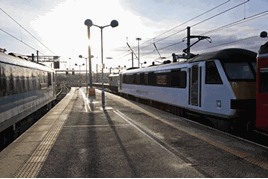In August 2014, AGA’s then new Managing Director Jamie Burles told RAIL that on neighbouring AGA routes, companies had ordered new trains, and that it was now AGA’s turn (RAIL 756).
The same argument could be made for infrastructure. On the East Coast Main Line, platforms are being extended for Intercity Express Programme and new Thameslink trains; the Midland Main Line was to have been electrified (although this has been “paused” by McLoughlin); the North London Line has been modernised; the £6 billion Thameslink scheme is four stops away on the Tube from Liverpool Street; the East London Line crosses the GEML at Shoreditch; the West Coast Main Line upgrade was completed in the mid-2000s; the Great Western Main Line is being electrified; and Peterborough station has been significantly remodelled.
Meanwhile, on the GEML, renewals are being carried out and Norwich station is getting barriers.
Other regions have campaigned vocally (and successfully) for investment, and now Anglia is doing the same. The message is (finally) being heard, but it has taken a lot of hard work and dedication.
Norwich North MP Chloe Smith is co-chairman of the Great Eastern Rail Taskforce. A passionate supporter of the ‘Norwich in 90’ project, Smith tells RAIL: “I’m the Norfolk representative. We have Ben Gummer for Suffolk and Simon Burns for Essex. I have led the campaign for some years. I pulled the four counties together as it was my initiative to do so.
“East Anglia has missed out. It hadn’t pulled together before. It couldn’t be seen to benefit individually. But you can change political will when joined up. We think it can help by having cross-party political support, and we have that.”
Smith was speaking on June 30, less than eight weeks after the General Election, the outcome of which was crucial for the Taskforce’s plans. The proposed GEML upgrade and possible new train fleet relies on a new franchise due to start in October 2016, but Labour had vowed to put a stop to re-franchising. That could have jeopardised plans, but instead the Conservatives won a majority government.
“If Labour had been elected then this would have gone backwards,” says Smith. “East Anglia was particularly vulnerable because of the franchising. I am delighted we are past that agenda now.
“With Patrick McLoughlin remaining there is political stability. I have a huge amount of respect for him. He fully understands this. Passengers are always at the forefront and we cannot go on without this.”
Smith is speaking five days after McLoughlin “paused” Midland Main Line and trans-Pennine electrification. These are massive projects. Were there fears for the GEML upgrade?
“We believe the announcement keeps things on course. We always said it was important for Norfolk and Suffolk to get our fair share. It is a relatively modest investment spread over ten years for Control Period 5 and CP6. When you add strong commitment from the Secretary of State we think our work remains on track. We expect Network Rail to continue.”
Meanwhile, the Taskforce’s work continues: “We are proceeding as planned and analysing what can be achieved.”
With the long-term franchise up for grabs, bidders will meet with the Taskforce.
“We want to make sure the bidders see the passion and what the region needs,” says Smith.
“East Anglia has had historic underinvestment. We know it can prosper, and it deserves this. Thousands of jobs can come to the region. It would give opportunities for people. It’s just not on that London to Brussels is the same journey time as Norwich to London. Passengers deserve better.”
‘Better’ includes new trains. “We have gone all out for new trains. We have the political commitment.”
The question remains: what kind of rolling stock? Passenger numbers are higher the further south you travel along the GEML, so surely commuter stock is required?
“It’s an inter-city and commuter route. The volume of commuters means that it needs all of the requirements. The upgrade is as much political as it is technical.”
Smith is also happy with the perception of the Taskforce: “It has earned a reputation as a great example of campaigning.”
Network Rail is backing the Taskforce, and Anglia Route Managing Director Richard Schofield forms part of the industry’s representation in campaigning for the upgrades.
NR spokesman Sam Kelly says: “To support the Great Eastern Rail Taskforce’s aspiration to reduce journey times between London and Norwich to 90 minutes, we are carrying out a feasibility study looking into what infrastructure upgrades are necessary to achieve this aim. We have just started this study, and it won’t be complete until November.
“The Great Eastern Main Line is a vital economic artery for East Anglia, connecting growing numbers of people and businesses in Essex, Suffolk and Norfolk with the capital. We will continue our work to deliver a better and more reliable railway, modernising track and overhead power lines.”
Kelly explains that NR believes there are three key elements to achieving Norwich in 90: infrastructure upgrades to deliver line speed improvements (what the study is looking at); timetable changes; and the introduction of new rolling stock.
The study will look at four sections on the GEML: Stratford-Shenfield, Shenfield-Colchester, Manningtree-Ipswich, and Ipswich-Trowse Lower Junction. It will consider timescales for any infrastructure upgrades, as well as any changes that may be needed to level crossings along this route.
It is believed that £476 million will be enough for the improvements, although campaigners are adamant that they could unlock economic potential worth almost ten times that figure.
On November 4 2014, the Great Eastern Main Line Taskforce released its The Business Case: Release the Potential report (RAIL 761), which makes the case for investment in the Great Eastern Main Line.
The report states that the current average speed of London-Norwich GEML trains is 63mph, resulting in slower journey times than from London to Stoke, Nottingham, York or Bristol (all further distances than the 115 miles between Norwich and London). It also highlights that currently 18% of peak-hour passengers arriving at London Liverpool Street have to stand (excluding the Metros).
The economy is at the heart of the plans. Europe’s biggest insurance cluster is based in the region, while BT has its European research and development headquarters there. The UK’s largest container port is at Felixstowe, on the Suffolk coast, while the ‘energy coast’ has £50bn of potential investment for nuclear, gas and renewable energy production.
But while the railway requires improvements, no community should have a worse service than it currently does if and when the campaign reaches fruition, Taskforce co-chairman Mark Pendlington told RAIL on June 11 (RAIL 777).
“The one thing is not to start a hare running,” he says. “What we say is the timetable must improve. The quality of the service must not let anyone down. No community must be left with a service worse than it has now.”
Pendlington tells RAIL that lessons must be learned from East and West Coast Main Line timetable recasts, where certain towns and cities had their connections vastly changed, and criticised.
He says that 48,000-50,000 new jobs in the Norfolk, Suffolk and Essex region is the prize for investment “if we get this right”, adding: “One key component is new rolling stock. The trains must be high quality. It is things like reliability, plugs and WiFi. If you are a family or a businessman off to an important meeting, that train should be equipped to get you there.”















Login to comment
Comments
No comments have been made yet.